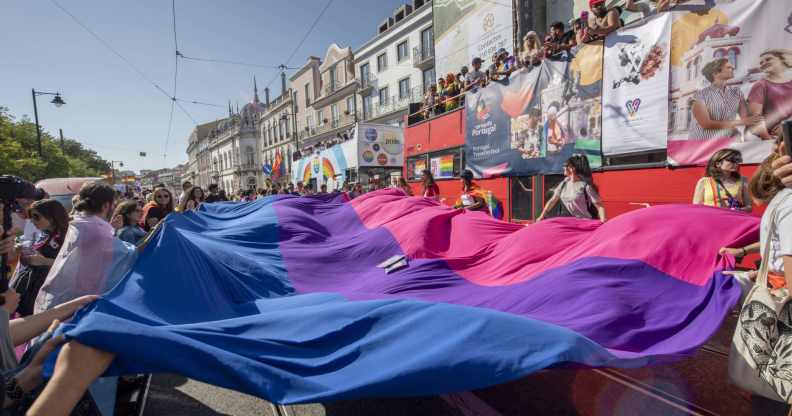Plans for a bisexual flag emoji have been rejected by Unicode Consortium

Participants display a bisexual pride flag during a 2019 pride parade in Lisbon, Portugal. (Horacio Villalobos/Corbis via Getty Images)
Participants display a bisexual pride flag during a 2019 pride parade in Lisbon, Portugal. (Horacio Villalobos/Corbis via Getty Images)
Plans for a bisexual flag emoji have been rejected by the Unicode Consortium, the body that governs the internationally-recognised symbols.
Emoji have had a long road towards LGBT-inclusivity, with updates in recent years to add rainbow flags and gender-neutral people to the list of internationally-recognised symbols.
The most recent emoji list added support for trans pride flags, after a long battle to get the symbol recognised on the platform.
But campaigners seeing to add a bisexual flag emoji have faced a setback after their bid was rejected by the Unicode Consortium, the small group of tech figures responsible for approving or rejecting proposals for new emoji.
Bisexual pride flag emoji won’t be coming to phones any time soon
Bisexual activist Tanner Marino, who had put forward a proposal to add the bi pride flag, criticised the rejection. No reason for the decision was made public.
He said: “I knew this wouldn’t be easy from the start. The transgender flag emoji required multiple submissions, a team of people, and intense media coverage. I was the only person who worked on this first submission. That may have been a mistake, but I wanted to submit the proposal in time for the deadline.”
Marino has since set up a Change.org petition on the issue, which has attracted nearly 10,000 signatures.

People marching with anBi, a bisexual organization, carry a bisexual flag in the LA Pride Parade (David McNew/Getty Images)
He wrote: “Recently, the following new emoji were released: a plunger, an olive, a dodo bird, and a beaver. Notably, the transgender flag was included. Seeing that the powers that be finally were open to inclusive representation, a bisexual flag emoji was proposed – and rejected, for no reason.
“What’s more important, the bisexual community or a plunger?
“Emojis are a way for the world to connect and express themselves – regardless or region or language – and bisexual people shouldn’t be left out.
“Certainly, if big tech companies can sign off on a plunger emoji, they can also allow an emoji for people to express their sexual orientation. Especially considering over half of LGB people identify as bisexual.”
Emoji proposals face an uphill battle
The Unicode Consortium website says: “The submission and selection process isn’t affected by simple suggestions, nor by petitions, nor by letters/tweets from celebrities/government officials.
“People should instead focus their efforts on working together to provide compelling evidence in complete submission forms for the emoji they want. If people have ideas, they should try to connect with others so that that they can all can help put together a solid proposal.”
New emoji must satisfy the characteristics of “high expected usage, distinctiveness and broad scope”, the body explains, adding: “People need to make a compelling case that their proposals are stronger than the many others submitted, since there is a limited capacity for encoding new emoji characters each year.”

